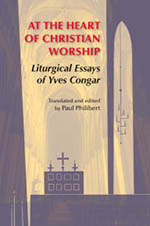Book Review: At the Heart of Christian Worship: Liturgical Essays of Yves Congar. Translated and edited by Paul Philibert
At the Heart of Christian Worship: Liturgical Essays of Yves Congar. Translated and edited by Paul Philibert
(Collegeville, MN: Liturgical Press, 2010). 156 pages. $24.95

At this writing, this week marked the 53rd anniversary of the impactful Constitution of the Sacred Liturgy, Sacrosanctum Concilium, promulgated by Pope Paul VI. As one of the decisive pronouncements resulting from the Second Vatican Council, Sacrosanctum Concilium continues to influence the modern ecumenical and liturgical movements, particularly in its emphasis on the active participation of the worshipping assembly, its discussion on the sacraments and the Church, and calling the Church to inculturate worship through the lens and life of local contexts.
Liturgical scholar Paul Philibert provides us a gift in his translation of representative essays of Cardinal Yves Congar’s reflections on the liturgy as one who participated in the proceedings of Second Vatican. Thus, we receive theological reflection from a firsthand observer/participant who knew the intentions of Second Vatican in its liturgical pronouncement. More than that, Congar brings to bear his acumen at synthesizing a vast amount of patristic and medieval sources in conversation with contemporary voices in the 20th century, giving a primer to the ecclesiological and liturgical expressions of an earlier papal encyclical Mediator Dei (1947) by Pope Pius XII, arguably a document that paved the way for Sacrosanctum Concilium.
What Congar does is underscore the practical, pastoral and spiritual implications of the Church and the sacraments. For instance, he averred that what constitutes “real” preaching and “real” sacraments is when the reality of God’s grace and the communion with God infuses the heart of the believer so that Christians will live out what it means to love God and to love neighbor. Or, Congar discussed church orders and the various dimensions of priesthood at baptism, of justice, of parenting, and the unique priesthood of Christ. The first three are derivatives of Christ’s supreme priesthood, which enables the Church through its members and its clergy to render service as an act of offering in the various arenas of life. Congar’s writings are a good introduction to basic Catholic sacramental theology and ecclesiology, in his careful discussion of the Mass, the role of the Church in being united to Christ in his mission through the Spirit, in his description of the Church as the body of Christ both in its membership, in its connection with Christ as the Head, and in the Eucharistic host.
The title of this volume, “At the Heart of Christian Worship,” speaks to what Congar believed was at the heart of Christian worship: namely Jesus Christ, and the Lord’s partnership with the Church. Even as he explicated the significance of the assembly’s participation in worship and sometimes critiqued the Church for its past in discounting the laity or holding private masses to the exclusion of the assembly, Congar understood that the Church would not be the Church without Christ, and that Christ himself is integrally united to the Church. Thus, all that the Church does in its worship, in its offering, in its mission is derivative of Christ, who calls the Church into being and who, by the Holy Spirit, continues to use the Church for Christ’s mission in the world.
Although many subscribers to this journal belong to the various Protestant ecclesial traditions, the spirit of ecumenism, in our worship, in our mission, and in our preaching, it behooves us to read, reflect upon, and study Congar’s thoughts. His is another important lens into what it means to be the Church, how our life on this side of heaven is a relationship with and response to God and God’s revelation in Christ through the Spirit, and that the dividing wall of sacred and profane, as Congar put it, is a permeable one because of the comprehensive nature of the Lord’s love and mercies for all of creation.


